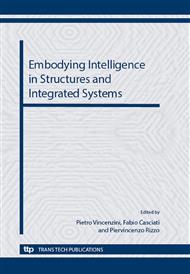p.95
p.105
p.115
p.122
p.132
p.138
p.144
p.151
p.157
SHM System for Monitoring and Prediction of Cracks Development in Concrete Structures
Abstract:
This paper describes the concept of monitoring the massive concrete structures based on the inverse problem solution. Properties of young concrete are changing very intensively in the early stage of hydration process, and therefore it is very important to know material constants as a function of age of concrete in order to accurately modeling the phenomena occurring in it. The main idea is to determine the time-dependent thermal properties of concrete on the basis of point temperature measurements in a small laboratory molds. Then, based on these parameters, the coupled thermo-mechanical equations are solved to describe the maturation and aging of concrete. This allows to specify (at the design stage) the potential risk of structural damage (e.g. thermal cracking) and thus prevent them e.g. through the use of intelligent cooling systems. Own, based on finite element method, software TMC (Thermal & Mechanical modeling of Concrete) gives also the possibility of predicting the formation of cracks during the aging of structure, which will be verified by means of electric sensor networks (so called ELGRID). This integration will enable to provide a complete system for monitoring and prediction of the structural stress state and damage development.
Info:
Periodical:
Pages:
132-137
Citation:
Online since:
September 2012
Authors:
Price:
Сopyright:
© 2013 Trans Tech Publications Ltd. All Rights Reserved
Share:
Citation:


